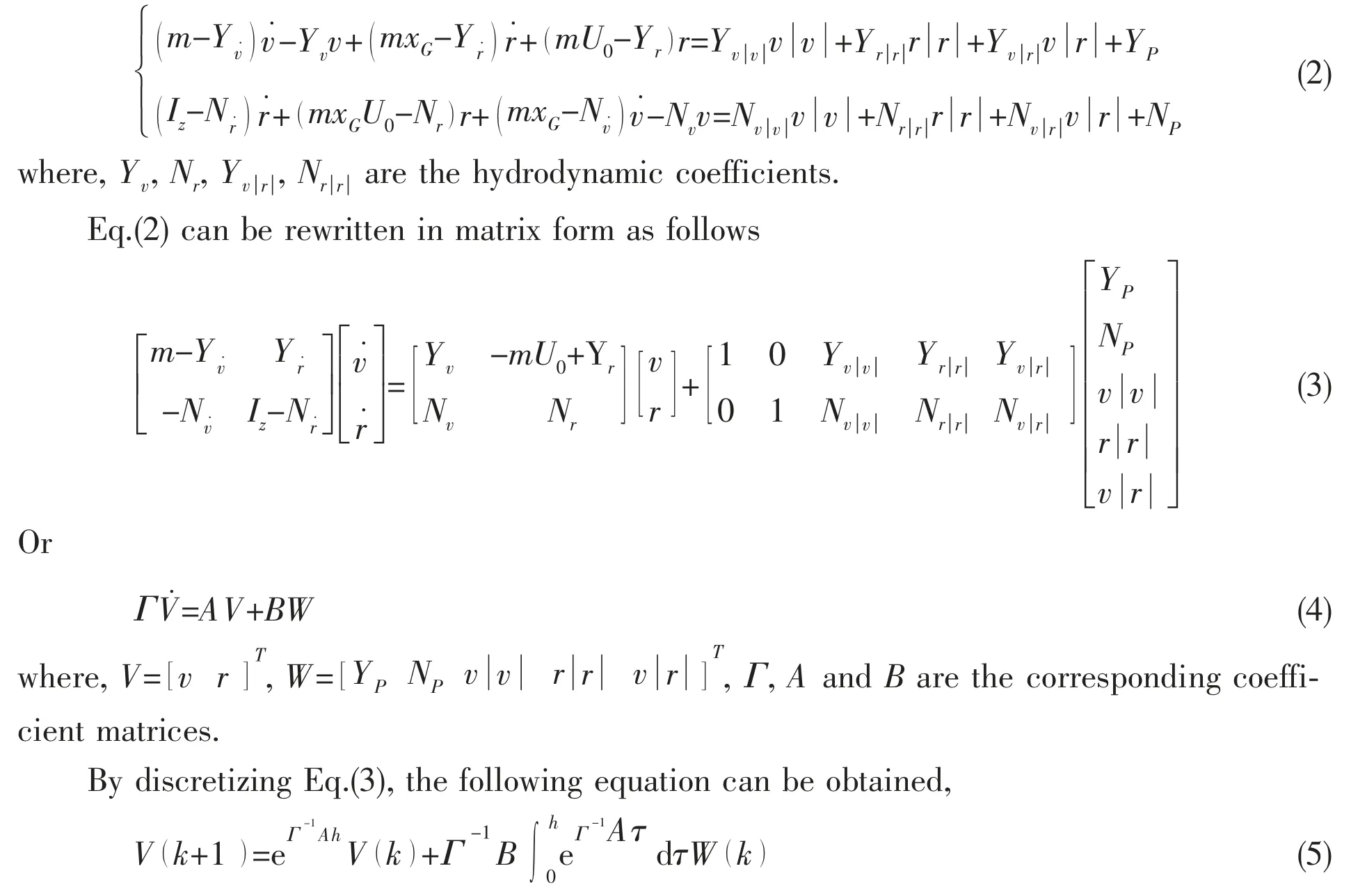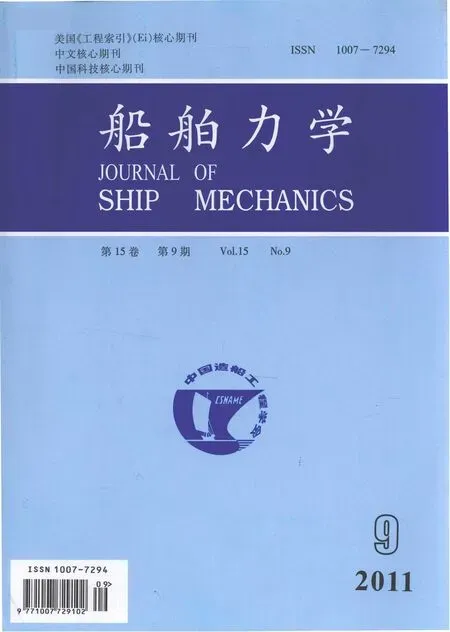Parametric Identification of AUV’s Maneuvering Motion Based on Support Vector Machines
XU Feng,ZOU Zo-jin ,b,SONG Xin
(a.School of Naval Architecture,Ocean and Civil Engineering;b.State Key Laboratory of Ocean Engineering,Shanghai Jiao Tong University,Shanghai 200240,China)
1 Introduction
Ocean is the important fields for human living and sustainable development.The exploration and utilization of ocean is extraordinary important for a country,and it has become a crucial battlefield for resource competition.AUVs(Autonomous Underwater Vehicles)play an irreplaceable role on the exploration and exploitation of ocean resources.At present,AUV are mainly used for underwater rescue,marine exploration sampling,underwater measurement,and so on.To accomplish all kinds of complicated underwater tasks,maneuverability and safety are the basic requirements that AUV should satisfy.Therefore,the research on maneuverability and control system of AUV is of great significance.
In the research of AUV’s maneuverability,the motion equation of six degrees of freedom,i.e.,the mathematical model describing AUV’s spatial motion should be first established.To build up the mathematical model,the pivotal problem is precisely determining the hydrodynamic coefficients and environmental disturbance coefficients.For the inertia coefficients,the captive model test by PMM(Planar Motion Mechanism),estimation with empirical formula and theoretical or numerical calculation based on potential theory can be used.There are also four fre-quently-used methods for the viscous coefficients,which are empirical formula method,captive model test,CFD(Computational Fluid Dynamics)method and system identification method by analyzing the model or full-scale test data.
System identification method is one of the effective methods for identifying the mathematical model of AUV’s maneuvering motion.There are many methods of system identification including the traditional ones and those based on artificial intelligence technology.The traditional methods include least square method(LSM),extended Kalman filter(EKF)method[1],maximum likelihood(ML)method[2],and so on.Neural network(NN)[3]and Support Vector Machines(SVM)[4]are two important artificial intelligent methods.Two serious defects,i.e.,the bad generalization performance and the curse of dimensionality,restrict the application of NN.SVM is originally used to deal with classification problem,but it performs very well for regression.It is based on the law of minimization of structural risk,considering both empirical risk and level of confidence,which consequently improves its generalization.SVM includes least square support vector machines(LS-SVM),εsupport vector machines(ε-SVM),νsupport vector machines(ν-SVM),and so on.Luo and Zou identified the mathematical model of surface ship’s maneuvering motion with SVM and satisfactory results are gained[5].
This paper makes an effort to apply SVM to identify the hydrodynamic coefficients in the mathematical model of AUV’s maneuvering motion.The mathematical model is reconstructed at first based on the VPMM(Vertical Planar Motion Mechanism)test[6].Then the hydrodynamic coefficients are identified from the free-running model test results by using LS-SVM.By comparing the identified parameters with those obtained by VPMM test,the validity of LSSVM in identifying AUV’s motion parameters is proved.At last,the mathematical model is verified by the identified parameters.
2 Mathematical model of AUV's maneuvering motion
To describe the motion characters of AUV,two reference frames are established.One is the fixed inertial frame of E-ξηζ(global coordinates),and the other is the bodyfixed moving frame G-xyz(local coordinates).Two frames are shown in Fig.1.
Generally,we should consider all the six degrees of freedom motion of AUV[7].However,at the weak maneuvering condition,the motion of AUV can be decomposed into two motions in the horizontal plane and in the vertical plane.Only the motion in the horizontal plane will be discussed in this paper.On the basis of rigid-body dynamics,the horizontal motion equation can be described as[8-9]


where,m is the mass of the AUV,Izis the moment of inertia,xG,yGare the coordinates of the gravity center,XH,YH,NHare the fluid forces and moments acting on the hull,XP,YP,Npare the forces and moments of propeller,u,v,r are the components of the speed and the yaw rate of AUV,u,v,r are the components of the acceleration and the angular acceleration.
The fluid forces and moments XH,YH,NHare expanded with Taylor series.Under the weak maneuvering condition,the longitudinal motion equation degenerates into an equilibrium equation with the balance between thrust and resistance.It is decoupled from the equation system and can be treated separately.On the other hand,the transverse equation and yaw equation are coupled and should be solved together.Normally,can be neglected because they are very small compared with other hydrodynamic coefficients.However,the VPMM test shows that the two parameters reach the magnitude of other coefficients and consequently they are considered as well.Thus the motion equation of horizontal plane can be reconstructed as

where,k is the time step,h is the sampling period.
According to the principle of parameter identifiability,inertial coefficients can be obtained by theoretical calculation or captive model tests rather than by system identification.Therefore,there are total 10 hydrodynamic coefficients to be identified including linear and nonlinear ones.
3 Least Square Support Vector Machines
SVM is initially applied in pattern recognition and classification problem and it shows commendable performance on research of regression algorithm in recent years.SVM has been widely adopted in model regression,prediction research and optimizing control and other aspects because of its strong learning ability and structural risk minimization rule.LS-SVM used in this paper is an improved type of SVM.
The feature space representation of LS-SVM is given by

where,C is rule factor,e is regression error.
Lagrangian function is defined for objective function and constraint conditions,

where,αiis Lagrangian multiplier.Partial derivative with respect to w,b,e,αgives:

Substituting the first and second formulas into the forth,subject to the third,gives

In consideration of the problem of motion parameter identification,linear Kernel function K(x,x′)=(x·x′)is commonly adopted.
4 Parametric identification
The test design is an important step for identification of the hydrodynamic coefficients.The purpose is to provide enough test data with sufficient information.Transverse control forces and moments are applied to AUV when it reaches the stable state of straight forward motion with constant speed.The time histories of the transverse speed and the heading angle are recorded,and the yaw rate is obtained from the heading angle.
LS-SVM is applied to analyze data of the transverse speed and yaw rate.The input-output samples are

The sampling number is 100 and the sample period is 0.5 s.Linear Kernel function is adopted,and penalty factor is taken as 3×104.100 couples of Lagrangian multipliers are identified.The hydrodynamic coefficients are calculated from the Lagrangian multipliers and input samples.The results are shown in Table 1.

Tab.1 Identification results of hydrodynamic coefficients(×10-5)
By comparing the identified coefficients with those obtained from VPMM test,it is not difficult to find out that the agreement is good for most of the coefficients,which indicates the validity of SVM in parametric identification of AUV.The discrepancy exists due to the difference between the model used in VPMM test and the free-running model which includes some appendages.
The time histories of the transverse speed and yaw rate are shown in Fig.2 and Fig.3,respectively,where the circle dots are the experimental results processed by Kalman filtering.

5 Model verification
Based on Eq.(5)in which the hydrodynamic coefficients are identified by LS-SVM,the maneuvering motion of AUV is simulated.The results of the motion simulation are compared with experimental results as shown in Fig.4 and Fig.5,which demonstrate the identified hydrodynamic coefficients are credible.The discrepancy lies in many aspects,for example,time delay is not taken into account,and the calculation precision may all affect the results.

6 Summary
Hydrodynamic coefficients of AUV are identified by using LS-SVM,and they are compared with those obtained from VPMM test.The comparison indicates the validity of LS-SVM on parametric identification of AUV.According to the identified parameters,motion of AUV is simulated.The motion simulation results are agreeable with the experimental results,which show that the identified parameters are credible.
[1]Tiano A,Sutton R,Lozowichi A,Naeem W.Observer Kalman filter identification of an autonomous underwater vehicle[J].Control Engineering Practice,2007,15(6):727-739.
[2]Liu Jiancheng,Liu Xuemin,Xu Yuru.Application of maximum likelihood to identification of underwater vehicle(in Chinese)[J].Journal of Harbin Engineering University,2001,22(5):1-4.
[3]Van De Ven P,Johansen T,SØrensen A,Flanagan C,Toal D.Neural network augmented identification of underwater vehicle models[J].Control Engineering Practice,2007,15(6):715-725.
[4]Vapnik V N.Statistical Learning Theory[M].New York:John Wiley & Sons,1998.
[5]Luo W L,Zou Z J.Parametric identification of ship maneuvering models by using support vector machines[J].Journal of Ship Research,2009,53(1):19-30.
[6]Wang Bo.Research on Motion Simulation of a Small Underwater Vehicle(in Chinese)[D].Harbin:Harbin Engineering U-niversity,2009.
[7]Fossen T I.Guidance and Control of Underwater Vehicles[M].New York:John Wiley & Sons,1994.
[8]Li Ye,Liu Jiancheng,Shen Mingxue.Dynamics model of underwater robot motion control in 6 degrees of freedom(in Chinese)[J].Journal of Harbin Institute of Technology,2005,12(4):456-459.
[9]Shi Shengda.Submarine Maneuverability(in Chinese)[M].Beijing:National Defence Industry Press,1995.
- 船舶力学的其它文章
- Investigation of Sea Wave and Structure Modelling for Fatigue Assessment of Offshore Structures
- Research on Calculation Methods of Hydrodynamic Coefficients for Sections with Complex Shape
- Study of a Hybrid Method Based on FDM and MLSFD Method
- Numerical Simulation of Pressure Distribution in Vertical Water-entry Cavity
- Experimental Study on Resistance and Longitudinal Motion of High-speed Air Cavity Craft in Regular Waves

